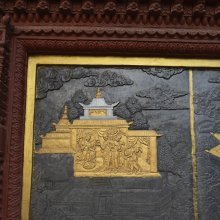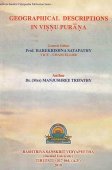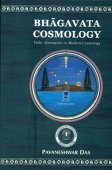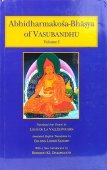Jambudvipa, Jambudvīpa, Jambu-dvipa: 33 definitions
Introduction:
Jambudvipa means something in Buddhism, Pali, Hinduism, Sanskrit, Jainism, Prakrit, the history of ancient India, Marathi. If you want to know the exact meaning, history, etymology or English translation of this term then check out the descriptions on this page. Add your comment or reference to a book if you want to contribute to this summary article.
Images (photo gallery)
In Hinduism
Purana and Itihasa (epic history)
Source: Wisdom Library: Varāha-purāṇaJambūdvīpa (जम्बूद्वीप) is one of the seven islands (dvīpa), ruled over by Āgnīdhra, one of the ten sons of Priyavrata, according to the Varāhapurāṇa chapter 74. Priyavrata was a son of Svāyambhuva Manu, who was created by Brahmā, who was in turn created by Nārāyaṇa, the unknowable all-pervasive primordial being.
These are the seven major mountains in Jambūdvīpa:
- Himavān,
- Hemakūṭa,
- Niṣadha,
- Meru,
- Nīla,
- Gandhamādana,
- Mālyavān.
The Varāhapurāṇa is categorised as a Mahāpurāṇa, and was originally composed of 24,000 metrical verses, possibly originating from before the 10th century. It is composed of two parts and Sūta is the main narrator.
Source: archive.org: Nilamata Purana: a cultural and literary studyJambudvīpa (जम्बुद्वीप) refers to one of the seven continents mentioned in the Nīlamatapurāṇa. Jambudvīpa has nine varṣas, namely, Uttarakuru, Ramya, Hairaṇvata, Bhadrāśva, Ketumāla, Ilāvṛta, Harivarṣa, Kimpuruṣa and Bhāratavarṣa, and the last one is further divided into nine parts of which the ninth one alone seems to represent India proper.
Source: archive.org: Puranic EncyclopediaJambūdvīpa (जम्बूद्वीप).—One of the Purāṇically famous Saptadvīpas (seven continents). These seven continents are embankments separating the seven seas. Jambūdvīpa, Krauñcadvīpa, Śākadvīpa and Puṣkaradvīpa are included in the seven islands. (See full article at Story of Jambū-dvīpa from the Puranic encyclopaedia by Vettam Mani)
Source: Cologne Digital Sanskrit Dictionaries: The Purana IndexJambūdvīpa (जम्बूद्वीप).—People of, described. See Jambū.*
- * Vāyu-purāṇa 46. 25-37.

The Purana (पुराण, purāṇas) refers to Sanskrit literature preserving ancient India’s vast cultural history, including historical legends, religious ceremonies, various arts and sciences. The eighteen mahapuranas total over 400,000 shlokas (metrical couplets) and date to at least several centuries BCE.
Kavya (poetry)
Source: Shodhganga: A critical appreciation of soddhalas udayasundarikathaJambūdvīpa (जम्बूद्वीप).—One of the seven continents (dvīpa) of Bhūrloka (earth).—In the midst of all dvīpas there is Jambūdvīpa. It is situated in the middle of the other dvīpas having, three dvīpas on each side. It consists of a big tree named Jambū and also the river and the mountain of the same name and hence it is said to be Jambūdvīpa. The Jambūdvīpa is encircled by the salt ocean, Lavaṇa-samudra.
A number of mountains in Jambūdvīpa are mentioned by Soḍḍhala. They are as under:—
- Mandara,
- Gandhamādana,
- Vipula,
- Supārśva,
- Niṣadha,
- Hemakūṭa,
- Himādri,
- Śṛṅgavān,
- Śvetācala,
- Nīlagiri
- and Sumeru.
Jambūdvīpa (जम्बूद्वीप) is the name a locality mentioned in Rājaśekhara’s 10th-century Kāvyamīmāṃsā.—It is the famous one of the seven Dvīpas in the world. This is situated in the middle of three Dvīpas on both sides. At present times this Dvīpa may identified with the Asia and the mountain Mahāmeru, is situated in the middle of this Jambūdvīpa. According to Purāṇas and Rājaśekhara’s Kāvyamīmāṃsā, this Jambūdvīpa is consists of seven varṣas or parts and seven mountains. The Bhāratavarṣa is the southern-most varṣa or country in the Jambūdvīpa and includes within its boundary the mighty Himālayas.

Kavya (काव्य, kavya) refers to Sanskrit poetry, a popular ancient Indian tradition of literature. There have been many Sanskrit poets over the ages, hailing from ancient India and beyond. This topic includes mahakavya, or ‘epic poetry’ and natya, or ‘dramatic poetry’.
Shaivism (Shaiva philosophy)
Source: Wisdom Library: ŚaivismJambūdvīpa (जम्बूद्वीप) refers to one of the seven continents (saptadvīpa) situated within the world of the earth (pṛthivī), according to Parākhyatantra 5.61. It is also known as plainly Jambū. These continents are located above the seven pātālas and may contain even more sub-continents within them, are round in shape, and are encircled within seven concentric oceans.
Jambūdvīpa is divided into the following nine landmasses (navakhaṇḍa):
- Bhārata-khaṇḍa,
- Hari-khaṇḍa,
- Kimpuruṣa-khaṇḍa,
- Ramyaka-khaṇḍa,
- Ramaṇa-khaṇḍa,
- Kuru-khaṇḍa,
- Bhadrāśva-khaṇḍa,
- Ketumāla-khaṇḍa,
- Ilāvṛta-khaṇḍa.
In the middle of them is situated the golden mountain named Meru which rises above the surface of the earth by 84,000 yojanas while it penetrates the circle of the earth to a depth of sixteen yojanas.
According to the Parākhya-tantra, “all this is called the continent Jambu, where the Jambu tree with large fruits grows. Because of contact with the juices that come from those arises the gold known as Jāmbūnada. outside that is the ocean (sāgara) of salt water that was created bythe sons of Sagara”.
The Parākhyatantra is an old Śaiva-siddhānta tantra dating from before the 10th century.

Shaiva (शैव, śaiva) or Shaivism (śaivism) represents a tradition of Hinduism worshiping Shiva as the supreme being. Closely related to Shaktism, Shaiva literature includes a range of scriptures, including Tantras, while the root of this tradition may be traced back to the ancient Vedas.
Vaishnavism (Vaishava dharma)
Source: Pure Bhakti: Brhad BhagavatamrtamJambudvīpa (जम्बुद्वीप) refers to:—The island of Jambu, situated in the earthly planetary system Bhū-maṇḍala. (cf. Glossary page from Śrī Bṛhad-bhāgavatāmṛta).
Source: VedaBase: Śrīmad BhāgavatamJambūdvīpa (जम्बूद्वीप) encircles Mount Sumeru, according to the Bhāgavata-purāṇa (Śrīmad Bhāgavatam) verse 5.20.—Accordingly, “As Sumeru Mountain is surrounded by Jambūdvīpa, Jambūdvīpa is also surrounded by an ocean of salt water. The breadth of Jambūdvīpa is 100,000 yojanas [800,000 miles], and the breadth of the saltwater ocean is the same. As a moat around a fort is sometimes surrounded by garden-like forest, the saltwater ocean surrounding Jambūdvīpa is itself surrounded by Plakṣadvīpa. The breadth of Plakṣadvīpa is twice that of the saltwater ocean — in other words 260,000 yojanas [1,600,000 miles]. [...]”.

Vaishnava (वैष्णव, vaiṣṇava) or vaishnavism (vaiṣṇavism) represents a tradition of Hinduism worshipping Vishnu as the supreme Lord. Similar to the Shaktism and Shaivism traditions, Vaishnavism also developed as an individual movement, famous for its exposition of the dashavatara (‘ten avatars of Vishnu’).
General definition (in Hinduism)
Source: Wisdom Library: HinduismContinent Jambudvipa (Indian Blackberry Island), also known as Sudarshanadvipa, forms the innermost concentric island in the above scheme. Its name is said to derive from a Jambu tree (another name for the Indian Blackberry). The fruits of the Jambu tree are said, in the Viṣṇupurāṇa (ch.2) to be as large as elephants and when they become rotten and fall upon the crest of the mountains, a river of juice is formed from their expressed juice. The river so formed is called Jambunadi (Jambu river) and flows through Jambudvipa, whose inhabitants drink its waters. Insular continent Jambudvipa is said to comprise nine varshas (zones) and eight significant parvatas (mountains).
Markandeya Purana portrays Jambudvipa as being depressed on its south and north and elevated and broad in the middle. The elevated region forms the varsha named Ila-vrta or Meruvarsha. At the center of Ila-vrta lies the golden Mount Meru, the king of mountains. On the summit of Mount Meru, is the vast city of Lord Brahma, known as Brahmapuri. Surrounding Brahmapuri are 8 cities - the one of Lord Indra and of seven other Devatas.
Markandeya Purana and Brahmanda Purana divide Jambudvipa into four vast regions shaped like four petals of a lotus with Mount Meru being located at the center like a pericarp. The city of Brahmapuri is said to be enclosed by a river, known as Akash Ganga. Akash Ganga is said to issue forth from the foot of Lord Vishnu and after washing the lunar region falls "through the skies" and after encircling the Brahmapuri "splits up into four mighty streams", which are said to flow in four opposite directions from the landscape of Mount Meru and irrigate the vast lands of Jambudvipa.
Source: WikiPedia: HinduismJambudvīpa (जम्बुद्वीप): The name of the dvipa ("continent") of the terrestrial world, as envisioned in the cosmologies of Hinduism, Buddhism, and Jainism, which is the realm where ordinary human beings live. Its name is said to derive from a Jambu tree.
Source: Vaniquotes: HinduismIn Jambūdvīpa there are nine divisions of land, each with a length of 9,000 yojanas, 72,000 miles: Bhārata-varṣa, Kimpuruṣa-varṣa, Hari-varṣa, Bhadra-varṣa, Ilāvṛta-varṣa, Ketumāla-varṣa, Ramyaka-varṣa, Hiraṇmaya-varṣa, and Kuru-varṣa.
In Buddhism
Tibetan Buddhism (Vajrayana or tantric Buddhism)
Source: OSU Press: Cakrasamvara SamadhiJambudvīpa (जम्बुद्वीप) is the name of a deity or entity to which is given homage to [i.e., oṃ raṃ jambudvīpāya namaḥ], according to the Guru Mandala Worship (maṇḍalārcana) ritual often performed in combination with the Cakrasaṃvara Samādhi, which refers to the primary pūjā and sādhanā practice of Newah Mahāyāna-Vajrayāna Buddhists in Nepal.
Source: MDPI Books: The Ocean of HeroesJambūdvīpa (जम्बूद्वीप) refers to the “Jambū continent”, according to the 10th-century Ḍākārṇava-tantra: one of the last Tibetan Tantric scriptures belonging to the Buddhist Saṃvara tradition consisting of 51 chapters.—Accordingly, [while explaining the water-circle (jalacakra)]: “[...] This, the Jambū continent (jambūdvīpa), is thereby divided into twelve sections. The ocean is named Saline—all creatures belonging to it are associated with the moisture-born [deities on the Water Circle]. [He should understand] humans to be among the womb-born. The moisture-born belong to this, [the Water] Circle. The womb-born belong to the Fire Circle. Replete with all [kinds of good] characteristics, [the Water Circle] itself has the nature of wisdom and means. The Water Circle, the second, is thus [taught]. [...]”.

Tibetan Buddhism includes schools such as Nyingma, Kadampa, Kagyu and Gelug. Their primary canon of literature is divided in two broad categories: The Kangyur, which consists of Buddha’s words, and the Tengyur, which includes commentaries from various sources. Esotericism and tantra techniques (vajrayāna) are collected indepently.
General definition (in Buddhism)
Source: Wisdom Library: Buddhism1) Jambudvīpa is the region where the humans live and is the only place where a being may become enlightened by being born as a human being. It is in Jambudvīpa that one may receive the gift of Dharma and come to understand the Four Noble Truths, the Noble Eightfold Path and ultimately realize the liberation from the cycle of life and death. Another reference is from the Buddhist text Mahavamsa, where the emperor Ashoka's son Mahinda introduces himself to the Sri Lankan king Devanampiyatissa as from Jambudvipa, referring to what is now the Indian subcontinent.
2) Jambudvipa:—The entire human world.
Source: Wisdom Library: Dharma-samgrahaJambudvīpa (जम्बुद्वीप) in the centre refers to one of the “four continents” (dvīpa) as defined in the Dharma-saṃgraha (section 120). The Dharma-samgraha (Dharmasangraha) is an extensive glossary of Buddhist technical terms in Sanskrit (e.g., jambu-dvīpa). The work is attributed to Nagarjuna who lived around the 2nd century A.D.
In Jainism
General definition (in Jainism)
Source: Wisdom Library: JainismJambūdvīpa (जम्बूद्वीप) is one of the continents (dvīpa) of the middle-world (madhyaloka), encircled by the ocean named Lavaṇasamudra (or simply Lavaṇa), according to Jain cosmology. The middle-world contains innumerable concentric dvīpas and, as opposed to the upper-world (adhaloka) and the lower-world (ūrdhvaloka), is the only world where humans can be born. Jambūdvīpa is also known as plainly Jambū.
Jambūdvīpa continent has 6 mountains, dividing the continent into 9 zones (Ksetra). The names of these zones are:
- Bharat Kshetra
- Mahavideha Kshetra
- Airavat Kshetra
- Ramyakwas
- Hariwas
- Hairanyvat Kshetra
- Haimavat Kshetra
- Devkuru
- Uttarkuru
Jambūdvīpa is recorded in ancient Jaina canonical texts dealing with cosmology and geography of the universe. Examples of such texts are the Saṃgrahaṇīratna in the Śvetāmbara tradition or the Tiloyapannatti and the Trilokasāra in the Digambara tradition.
Source: Google Books: Jaina IconographyJambūdvīpa (जम्बूद्वीप).—The Jambū-dvīpa, placed in the center of the middle world, is the most important of all the continents.
Six ranges of mountains divide this Jambū-dvīpa into seven regions (kṣetras):
- Bhārata (rivers Gaṅgā and Sindhu),
- Haimavanta (rivers Rohit and Rohitāsyā),
- Hari (rivers Harit and Harikāntā),
- Videha (rivers Sitā and Sitodā),
- Ramyaka (rivers Nārī and Narakāntā),
- Hairaṇyavata (rivers Suvarṇakūlā and Rūpyakūlā),
- Airāvata (rivers Raktā and Raktodā).
The six mountain ranges known as varṣadhara-parvatas are:
- Haimavat,
- Mahāhimavat,
- Niṣadha,
- Nīla,
- Rukmin,
- Śikharin.
On their tops are six lakes, namely,
- Padma,
- Mahāpadma,
- Tigiñcha,
- Kesarī,
- Mahāpuṇḍarīka,
- Puṇḍarīka.
Each having a big lotus-island (padmahrada) in its center.
In these islands live the six goddesses
- Śrī,
- Hrī,
- Dhṛti,
- Kīrti,
- Buddhi,
- Lakṣmī.
Attended by sāmānikas, gods of councils, bodyguards and armies.
Source: archive.org: TrisastisalakapurusacaritraJambūdvīpa (जम्बूद्वीप) is the name of an ancient continent where stands mount Meru, according to chapter 1.1 [ādīśvara-caritra] of Hemacandra’s 11th century Triṣaṣṭiśalākāpuruṣacaritra: an ancient Sanskrit epic poem narrating the history and legends of sixty-three illustrious persons in Jainism. Accordingly, “[...] there is a continent named Jambūdvīpa, enclosed by innumerable circles of oceans and continents, and surrounded by a diamond wall. It is adorned with rivers, zones, and mountains, and at its center, like a navel, stands Meru made of gold and jewels. It (Meru) is a lac of yojanas high, adorned with three terraces; and its peak, forty yojanas high, is adorned with shrines of the Arhats”.
Source: JAINpedia: GlossaryThe innermost island-continent in the Middle World, in Jain cosmology. It is divided into seven continents separated by six mountain ranges. It takes its name - 'Rose-Apple Continent' - from a rock formation that resembles a rose-apple tree, which is found on Mount Meru in the centre of the island.
Source: Shodhganga: A cultural study on the jain western Indian illustrated manuscriptsJambūdvīpa (जम्बूद्वीप).—The regions which the soul which is capable of gaining release will do are all situated in the middle world. Although much smaller in size than the lower and upper worlds. It is arranged around the “continent of the rose-apple tree” (jambūdvīpa), surrounded by precious, highly-wrought walls and a lotus terrace. Surrounding this disk, whose diameter is 100,000 yojanas, are set out horizontally to the farthest sea, which is impossible to reach, an incalculable series of concentric rings, of alternate oceans (samudras) and islands or continents (dvīpas).
Jambūdvīpa, especially is painted with long chains of mountains running from east to west divide it into seven countries, great rivers flow from peaks to the oceans and the division of the provinces can be seen in the large middle zone of videha, to the east and west of Mount Meru, whose peak dominates uttarakuru in the north, and devakuru in the south with their trees, jambuvṛkṣa and śālmalī.
The disk of jambūdvīpa is set within its rampart of diamonds which is surrounded by a fence of jewels crowned by a high garland of lotuses made from gems. It is washed by the lavaṇasamundra where the tides which regulate its months rise, where the islands of its moon and sun are situated and into which some of the mountains project.
Source: Encyclopedia of Jainism: Tattvartha Sutra 3: The Lower and middle worldsJambūdvīpa (जम्बूद्वीप) refers to the first continent of the Madhya-loka (middle-word), according to the 2nd-century Tattvārthasūtra 3.7. Jambūdvīpa derives its name from the Jambū tree which abounds on this continent. What type of tree is the Jambū tree? The Jambū tree is eternal, natural (not planted by anyone) and has ‘earth’ as its body (pṛhthivīkāyika).
Jambūdvīpa is divided into seven regions (separated by six dividing mountain ranges):
- Bhārata-varṣa,
- Haimavata-varṣa,
- Hari-varṣa,
- Videha-varṣa,
- Ramyaka-varṣa,
- Airāvata-varṣa,
- Hairaṇyavata-varṣa.
Jambūdvīpa is in the centre of all continents and oceans; all continents and oceans are concentric circles with Jambūdvīpa in the centre. Like the navel is in the centre of the body, Jambūdvīpa is in the centre of all continents and oceans. Sumeru Mount is in the centre of Jambūdvīpa. It is also called Mount Sudarśana.

Jainism is an Indian religion of Dharma whose doctrine revolves around harmlessness (ahimsa) towards every living being. The two major branches (Digambara and Svetambara) of Jainism stimulate self-control (or, shramana, ‘self-reliance’) and spiritual development through a path of peace for the soul to progess to the ultimate goal.
India history and geography
Source: Cologne Digital Sanskrit Dictionaries: Indian Epigraphical GlossaryJambu-dvīpa or Jambū-dvīpa.—(CII 1), used in the sense of ‘the earth’ or the dominions of the Maurya emperor Aśoka; cf. pṛthivī. Note: jambu-dvīpa is defined in the “Indian epigraphical glossary” as it can be found on ancient inscriptions commonly written in Sanskrit, Prakrit or Dravidian languages.

The history of India traces the identification of countries, villages, towns and other regions of India, as well as mythology, zoology, royal dynasties, rulers, tribes, local festivities and traditions and regional languages. Ancient India enjoyed religious freedom and encourages the path of Dharma, a concept common to Buddhism, Hinduism, and Jainism.
Languages of India and abroad
Marathi-English dictionary
Source: DDSA: The Molesworth Marathi and English Dictionaryjambudvīpa (जंबुद्वीप).—n (S jambu Rose-apple, said to abound there, and dvīpa A division of the earth.) The central division of the seven, i. e. the known continent, the real earth, as disting. from the fabulous six.
Marathi is an Indo-European language having over 70 million native speakers people in (predominantly) Maharashtra India. Marathi, like many other Indo-Aryan languages, evolved from early forms of Prakrit, which itself is a subset of Sanskrit, one of the most ancient languages of the world.
Sanskrit dictionary
Source: DDSA: The practical Sanskrit-English dictionaryJambudvīpa (जम्बुद्वीप) or Jambūdvīpa (जम्बूद्वीप).—Name of one of the seven continents surrounding the mountain Meru.
Derivable forms: jambudvīpaḥ (जम्बुद्वीपः), jambūdvīpaḥ (जम्बूद्वीपः).
Jambudvīpa is a Sanskrit compound consisting of the terms jambu and dvīpa (द्वीप). See also (synonyms): jambukhaṇḍa, jambuparvata.
Source: Cologne Digital Sanskrit Dictionaries: Shabda-Sagara Sanskrit-English DictionaryJambudvīpa (जम्बुद्वीप).—m.
(-paḥ) One of the divisions of the world. E. dvīpa a continent, added to jambu . jambuvṛkṣayuktaḥ dvīpaḥ . bhūmeḥ saptadvīpāntargate dvīpabhede .
Source: Cologne Digital Sanskrit Dictionaries: Benfey Sanskrit-English DictionaryJambūdvīpa (जम्बूद्वीप).—m. the name of one of the seven divisions of the world, and implying the central division, or the known world; according to the Bauddhas, it is confined to India, Mahābhārata 6, 207; [Lalitavistara, (in Bibliotheca Indica.)] 27.
Jambūdvīpa is a Sanskrit compound consisting of the terms jambū and dvīpa (द्वीप).
Source: Cologne Digital Sanskrit Dictionaries: Cappeller Sanskrit-English DictionaryJambudvīpa (जम्बुद्वीप).—[masculine] the continent abounding in roseapple trees, i.e. India, thought as one of the 7 Dvipas.
Source: Cologne Digital Sanskrit Dictionaries: Monier-Williams Sanskrit-English Dictionary1) Jambudvīpa (जम्बुद्वीप):—[=jambu-dvīpa] [from jambu] m. the central one of the 7 continents surrounding the mountain Meru (= India, [Buddhist literature]; named so either from the Jambu trees abounding in it, or from an enormous Jambu tree on Mount Meru visible like a standard to the whole continent), [Mahābhārata; Harivaṃśa] etc.
2) Jambūdvīpa (जम्बूद्वीप):—[=jambū-dvīpa] [from jambū > jambu] m. = bu-d
Source: Cologne Digital Sanskrit Dictionaries: Yates Sanskrit-English DictionaryJambudvīpa (जम्बुद्वीप):—[jambu-dvīpa] (paḥ) 1. m. The Hindu's central division of the world.
[Sanskrit to German]
Sanskrit, also spelled संस्कृतम् (saṃskṛtam), is an ancient language of India commonly seen as the grandmother of the Indo-European language family (even English!). Closely allied with Prakrit and Pali, Sanskrit is more exhaustive in both grammar and terms and has the most extensive collection of literature in the world, greatly surpassing its sister-languages Greek and Latin.
Kannada-English dictionary
Source: Alar: Kannada-English corpusJaṃbudvīpa (ಜಂಬುದ್ವೀಪ):—[noun] = ಜಂಬೂದ್ವೀಪ [jambudvipa].
--- OR ---
Jaṃbūdvīpa (ಜಂಬೂದ್ವೀಪ):—[noun] one of the seven mythological divisions of the world believed to be surrounding the mountain Mēru, which included India and its surroundings.
Kannada is a Dravidian language (as opposed to the Indo-European language family) mainly spoken in the southwestern region of India.
See also (Relevant definitions)
Partial matches: Jambu, Jampu, Dvipa.
Starts with: Jambudvipaka, Jambudvipanirnaya, Jambudvipanovicara, Jambudvipaprajnapti, Jambudvipasamgrahani, Jambudvipashirsha, Jambudvipavaralocana.
Ends with: Sarvajambudvipa.
Full-text (+1004): Jambudvipaprajnapti, Mandarahariṇa, Jambudvipaka, Svarnaprastha, Candrashukla, Nila, Meru, Jambukhanda, Shitoda, Jambudhvaja, Nishadha, Pancajanya, Agnidhra, Himahva, Jambudvipavaralocana, Ganga, Ketumala, Avartana, Harivarsha, Airavata.
Relevant text
Search found 93 books and stories containing Jambudvipa, Jambu-dvipa, Jambū-dvīpa, Jambu-dvīpa, Jambudvīpa, Jambūdvīpa, Jaṃbudvīpa, Jaṃbūdvīpa; (plurals include: Jambudvipas, dvipas, dvīpas, Jambudvīpas, Jambūdvīpas, Jaṃbudvīpas, Jaṃbūdvīpas). You can also click to the full overview containing English textual excerpts. Below are direct links for the most relevant articles:
Tattvartha Sutra (with commentary) (by Vijay K. Jain)
Verse 3.9 - Position, shape and extension of Jambūdvīpa < [Chapter 3 - The Lower World and the Middle World]
Verse 3.32 - The extent of Bharata < [Chapter 3 - The Lower World and the Middle World]
Verse 3.7 - The transverse world (tiryagloka) < [Chapter 3 - The Lower World and the Middle World]
Bhagavati-sutra (Viyaha-pannatti) (by K. C. Lalwani)
Part 4 - Sun-rise in Salt Sea < [Chapter 1]
Part 1 - On sun-rise and sun-set < [Chapter 1]
Part 2 - Measure of day and night < [Chapter 1]
Brihad Bhagavatamrita (commentary) (by Śrī Śrīmad Bhaktivedānta Nārāyana Gosvāmī Mahārāja)
Verse 2.2.8-9 < [Chapter 2 - Jñāna (knowledge)]
Verse 1.4.113 < [Chapter 4 - Bhakta (the devotee)]
Verse 1.4.114-115 < [Chapter 4 - Bhakta (the devotee)]
Puranic encyclopaedia (by Vettam Mani)
The Shiva Purana (by J. L. Shastri)
Chapter 17 - Description of the Jambūdvīpa (jambū-dvīpa) < [Section 5 - Umā-Saṃhitā]
Chapter 18 - Seven continents (varṣa) < [Section 5 - Umā-Saṃhitā]
Chapter 34 - The Story of Anaraṇya < [Section 2.3 - Rudra-saṃhitā (3): Pārvatī-khaṇḍa]
Related products
(+6 more products available)






